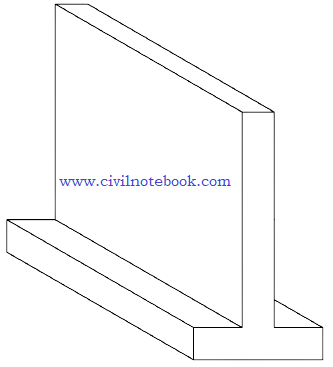Design of spread footing
Design of spread footing means determine the dimensions of footing and reinforcement required to safely distribute the load form soil. Below simple explanation of designing process of spread footing with their formula and dimensions:
7 step design of spread footing
1. The first step for design of spread footing is calculate the load it means calculating the vertical load that the footing needs to support. The load is typically obtained from the structural design of the buildings and specific requirement of the structures.

2. Calculate the bearing capacity of soil – The next step is calculating the bearing capacity of soil, which is the maximum pressure of soil is resist and safely support. This investigation is done by soil investigation and geotechnical engineering analysis.
3. Calculating the footing area – Footing area can be calculated by given formula:
A = P / q
Where, A = Area of footing
P = Load applied to the footing
Q = Allowable bearing capacity of the soil
If the footing area should be large, then distribute the load over the soil within the allowable bearing capacity.
4. Design the footing shape – Based on the architectural and structural characteristic and requirements of the load select a best footing such as rectangular, square, circular, and custom shape footing.
5. Calculate the footing dimensions – Once the above procedure is completed then calculate the footing dimensions.
For rectangular and square type footing dimensions such as length and width are calculated by given below formula:
Width = sqrt (A / L) Length =L
Where, Width = Width of the footing length
Length = Length of the footing
A = Area of the footing
L = Length to width ratio (typically assumed or specified)
For circular type footing, diameter calculated by given below formula:
Diameter = sqrt (4A/)
Where, Diameter = Diameter of the circular footing
A = Area of the footing =Pi (Approx – 3.14159)
6. Calculate the depth of footing – Depth of footing is dependent upon different factors such as soil conditions, stability requirements. When calculate the depth of footing always ensure that footing extends below the frost line and touch stable or hard layers.
7. Reinforcement design – The main purposes of reinforcement design in footing is resist the bending and shear force. The requirement of reinforcement is dependent upon the requirement of load, dimensions, and standard code. Bar sizes and spacing detailed calculation done by the structural engineers.
The important thing is more complex work of spread footing design. It includes soil properties, structural analysis, and settlement analysis. Without consulting of qualified structural engineers and geotechnical engineers can’t do it. The formula provide here are simplified and may not cover all the aspects of different design.
Uses Of Spread Footing
Generally, spread footings are used in different various construction projects. Major primary uses of spread footings are given below:
- Buildings – In large scale spread footing are used in different types of construction projects to support their individual columns and piers. Uses of spread footing are providing a stable foundation for multi-story buildings that is residential houses, industrial structures, and commercial facilities.
- Bridges – In our bridges spread footing are used for foundation for abutments and bridge piers. This footing is distributing the load to the soil and support for the vertical loads of the bridges.
- Tower and Transmission Structures – Spread footing are also used in the construction of tall towers, such a communication towers (mobile towers), transmission line towers and wind turbine. This footing provides a stable base for the vertical structure and help withstand wind and others dead load and live loads.
- Retaining Walls – Some of the construction of retaining walls spread footing are also be used. Spread footing are provide stability and support to the wall structure. This footing is helping to distribute the weight of the wall and resist lateral forces from soil pressure.
- Industrial Equipment – In the setting of industrial equipment and machine, spread footing are used to support heavy equipment and industrial structures. To the uses of spread footing, spread footing are provide a stable foundation for equipment such as large tanks, silos and machinery platforms.
- Foundation Repair and Retrofitting – Spread footing can also be used for repair of foundation and retrofitting projects. This footing is installed for provide additional support and strengthen for existing footing.
- Miscellaneous Structure – Spread footing are applicable for various structures, such as signboard, flagpoles, light poles, and others similar small construction.




Pingback: Spread Footing | 6 types | Advantages and disadvantages